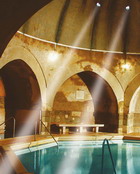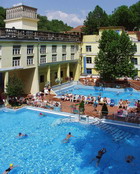
One of the very special things about Budapest is the prevalence of thermal springs right in the centre of the city. There are 118 springs and boreholes altogether, supplying the city’s spas and baths with 15.4 million gallons of water daily ranging in temperature from 70 to 170 degrees Fahrenheit (21-78°C).
One of the reasons the Romans first colonized the area immediately to the west of the River Danube and established their regional capital at Aquincum (now part of Óbuda, in northern Budapest) is so that they could utilize and enjoy the thermal springs. There are still ruins visible today of the enormous baths that were built during that period. The new baths that were constructed during the Turkish period (1541-1686) served both bathing and medicinal purposes, and some of these are happily still in use to this day. Budapest really gained its reputation as a city of spas in the 1920’s, following the first realization of the economic potential of the thermal waters in drawing in visitors. Indeed in 1934 Budapest was officially ranked as a “City of Spas.” Today, the baths are mostly frequented by the older generation, as, with the exception of the “Magic Bath” water discos, young people tend to prefer the lidos which are open in the summer.
THE TWO OLDEST BATHS:
(II. Fő u. 84.)
 Construction of the Király Baths started in 1565, and most of the present-day building dates from the Turkish period, including most notably the fine cupola-topped pool. In 1796 they were bought, renovated and extended by a family called König. König is the German word meaning “king,” and it is the Hungarian word Király with the same meaning that the Baths are known by today. Altogether there are four pools, the medicinal water for which is pumped in from the nearby Lukács Baths.
Construction of the Király Baths started in 1565, and most of the present-day building dates from the Turkish period, including most notably the fine cupola-topped pool. In 1796 they were bought, renovated and extended by a family called König. König is the German word meaning “king,” and it is the Hungarian word Király with the same meaning that the Baths are known by today. Altogether there are four pools, the medicinal water for which is pumped in from the nearby Lukács Baths.
Water temperatures: 79, 90, 99, 104 °F (26, 32, 36, 40ºC). Water surface area: 86, 108, 732, 42 sq. ft. Water mineral content: thermal water containing nitrates, calcium-magnesium-hydrogen-carbonates and sulphate-chlorides, as well as fluoride ions in significant quantities.
Opening times: Men only: Tuesdays, Thursdays and Saturdays 9.0 a.m. – 8 p.m. Women only: Mondays, Wednesdays and Fridays 7.0 a.m. – 6 p.m.
Rudas Medicinal Baths (I. Döbrentei tér 9.)
The Rudas Baths are not only superbly centrally placed – in the narrow strip of land between Gellért Hill and the River Danube – they are also an outstanding example of architecture dating from the Turkish period. The central feature is an octagonal pool over which light is thrown from a 30-foot diameter cupola, supported by eight pillars.
Water temperatures: 61-108°F (16-42°C). Pools: swimming pool and six further medicinal pools. Water mineral content: slightly radioactive thermal water containing nitrates, sulphates and calcium-magnesium-hydrogen-carbonates, as well as fluoride ions in significant quantities.
Opening times: Weekdays 6.0 a.m. – 8.0 p.m. Weekends 6.0 a.m. – 1.0 p.m. From 1936 up until 2005 the oldest, Turkish baths were open to men only. Since December 2005, in order to comply with a sex discrimination ruling, they have also been open to female bathers on certain days of the week.
Water temperatures in the medicinal baths: 61, 82, 86, 91, 99, 108 °F (16, 28, 30, 33, 36, 42 °C). Water surface area: 54, 97, 97, 97, 1,039, 97 sq. ft.
Water temperature in the swimming pool: 84°F (29 °C). Water surface area: 2,992 sq. ft. Water mineral content: slightly radioactive thermal water containing nitrates, sulphates and calcium-magnesium-hydrogen-carbonates, as well as fluoride ions in significant quantities.
THREE LARGE MEDICINAL BATHS
 Gellért Baths (XI. Kelenhegyi út 4.): The Gellért Baths and Hotel were built in 1918, although there had once been Turkish baths on the site, and in the Middle Ages a hospital. In 1927 the Baths were extended to include the wave pool, and the effervescent bath was added in 1934. With its immaculately preserved Art Nouveau interior, including colourful mosaics, marble columns, stained glass windows and statues, this is without doubt the most beautiful bathing complex in Budapest.
Gellért Baths (XI. Kelenhegyi út 4.): The Gellért Baths and Hotel were built in 1918, although there had once been Turkish baths on the site, and in the Middle Ages a hospital. In 1927 the Baths were extended to include the wave pool, and the effervescent bath was added in 1934. With its immaculately preserved Art Nouveau interior, including colourful mosaics, marble columns, stained glass windows and statues, this is without doubt the most beautiful bathing complex in Budapest.
The Gellért Baths were an immediate international success, and were even the scene of an early political scandal. In 1931 a visiting black doctor, Dr. Ramon Costello (who happened to be Cuban), was refused to the Baths on the grounds there were some white American visitors there, and, since there was still racial segregation in America, they objected to his presence. Costello took the matter to the City Council, and they found in his favour.
Water temperatures: 79-100°F (26-38°C). Pools: open air wave pool, thermal pool and children’s pool, indoor swimming-effervescent pool and nine medicinal pools.
Water mineral content: thermal water containing nitrates, calcium-magnesium-hydrogen-carbonates and sulphate-chlorides, as well as fluoride ions in significant quantities. Opening times: Weekdays 6.0 a.m. – 7.0 p.m. Weekends 6.0 a.m. – 5.0 p.m.
Lukács Medicinal Baths (II. Frankel Leó u. 25-29.)
 The Lukács Baths are also in Buda and are also Turkish in origin, although they were only revived at the end of the nineteenth century. This was also when the spa and treatment centre were founded. Happily, there is still something of an atmosphere of fin-de-siècle about the place, and all around the inner courtyard there are marble tablets recalling the thanks of patrons who were cured there. Since the 1950’s it has been regarded as a centre for intellectuals and artists.
The Lukács Baths are also in Buda and are also Turkish in origin, although they were only revived at the end of the nineteenth century. This was also when the spa and treatment centre were founded. Happily, there is still something of an atmosphere of fin-de-siècle about the place, and all around the inner courtyard there are marble tablets recalling the thanks of patrons who were cured there. Since the 1950’s it has been regarded as a centre for intellectuals and artists.
Water temperatures: 72-104°F (22-40°C). Pools: two outdoor swimming pools, fun pool, five indoor thermal pools.
Water mineral content: thermal water containing nitrates, calcium-magnesium-hydrogen-carbonates and sulphate-chlorides, as well as fluoride ions in significant quantities. Opening times: Weekdays 6.0 a.m. – 7.0 p.m. Weekends 6.0 a.m. – 5.0 p.m.
Széchenyi Baths (XIV. Állatkerti körút 11.)
 The Széchenyi Baths are one of the largest bathing complexes in all Europe, and the only “old” medicinal baths to be found in the Pest side of the city. The indoor medicinal baths date from 1913 and the outdoor pools from 1927. There is an atmosphere of grandeur about the whole place with the bright, largest pools resembling aspects associated with Roman baths, the smaller bath tubs reminding one of the bathing culture of the Greeks, and the saunas and diving pools borrowed from traditions emanating in northern Europe. The three outdoor pools (one of which is a fun pool) are open all year, including winter. Indoors there are over ten separate pools, and a whole host of medical treatments is also available.
The Széchenyi Baths are one of the largest bathing complexes in all Europe, and the only “old” medicinal baths to be found in the Pest side of the city. The indoor medicinal baths date from 1913 and the outdoor pools from 1927. There is an atmosphere of grandeur about the whole place with the bright, largest pools resembling aspects associated with Roman baths, the smaller bath tubs reminding one of the bathing culture of the Greeks, and the saunas and diving pools borrowed from traditions emanating in northern Europe. The three outdoor pools (one of which is a fun pool) are open all year, including winter. Indoors there are over ten separate pools, and a whole host of medical treatments is also available.
The thermal water is drawn from both natural springs and a 3,000-foot deep artesian well drilled in the 1870’s (the temperature of the water coming from this well is 165°F (74°C)). If you have seen winter pictures of men playing chess in an outdoor pool while the steam rises around them, then this is where they were taken.
Water temperatures: 68-100°F (20-38°C). Pools: outdoor swimming pool, fun pool and thermal pool, twelve indoor thermal pools. Water mineral content: thermal water containing nitrates, calcium-magnesium-hydrogen-carbonates and sulphate-chlorides, as well as fluoride ions and metaboric acid in significant quantities. Opening times: Daily 6.0 a.m. – 10.0 p.m.
See Hunguest Hotels in Budapest
Hunguest Hotel Platanus - on the way to airport, but close to the city centre
Tulip Inn Budapest Millennium - on the way to airport and close to the city centre